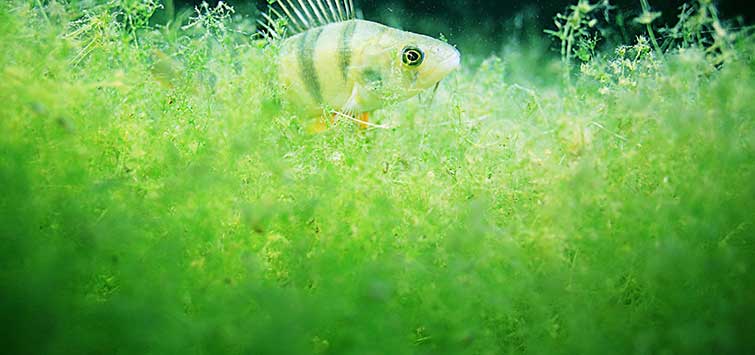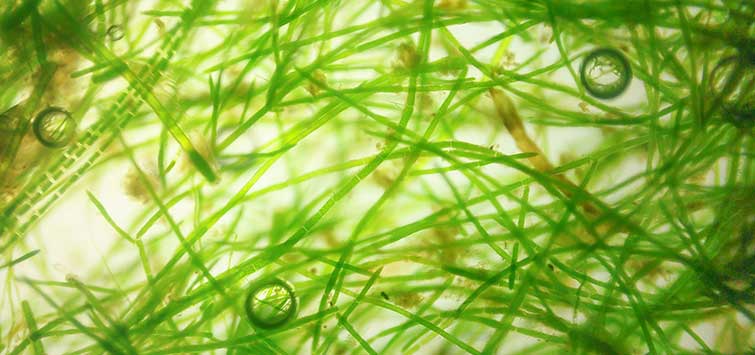The Skeptical Fishkeeper: Algae Detective
Author: Laura Muha
So there I was, elbow deep in one of my fish tanks a few weeks ago, trying to come up with a column topic as I scraped algae off the glass.
“What on earth am I going to write about (scrape, scrape) this month?” I wondered. “Maybe tank lighting?”
(Scrape, scrape, scrape.)
“Nah—already covered a good chunk of that topic last year.”
“How about (scrape, scrape) temperature?”
“Nah … mostly covered that one, too.”
Annoyed, I scraped harder, and an algae ribbon unfurled itself from the glass and swirled through the water column. Blasted algae! I was sick of dealing with the stuff. Despite my efforts, I knew that a brownish-green film would reappear on the glass in a matter of days, giving the tank a grungy look and making it difficult to see the fish clearly. None of my other tanks had a big algae problem; why did this one?
As I scraped and pondered, the thing that is undoubtedly obvious to you finally dawned on me: I’d just found the perfect topic for this month’s column. I was going to become an algae detective, hoping not only to get to the root of the problem in my tank but also to learn a few things that would help TFHreaders along the way. While in my case the tank in question was a saltwater tank, certainly enough of the fundamentals—and solutions to the problem—apply to fresh- and brackish-water systems as well.
Algae Basics
Since any good detective knows the importance of gathering background information on his or her quarry, I started my investigation by cracking open a biology textbook and reading up on algae.
The first thing I discovered, to my surprise, is that the word is plural; the singular form is “alga.” And that wasn’t the only thing that surprised me. If you’d asked me before starting this column whether algae were animal, vegetable or mineral, I would have unhesitatingly said “vegetable,” because so much of the stuff is green. But it turns out that the normal concepts of plant vs. animal actually get a little blurry when you’re talking about algae.
Yes, some species, such as giant kelp, do fit the traditional image of plants, complete with physical structures that resemble roots, stems and leaves (although in kelp-speak they’re called holdfasts, stipes, and blades, and they differ from their plant counterparts in ways that aren’t important to this discussion). But others species of algae, such as those known as euglenoids, are decidedly un-plant-like.
The smallest member of this group of single-celled organisms is about 1/1000 the size of a sesame seed, and all members of the genus have long tails, more properly known as flagella, that they use to propel themselves through the water. How many plants can do that?
What Are Algae?
But if algae are not plants, and most of us would agree they aren’t animals either, then what are they? Actually “algae” is used to describe a huge variety of organisms—from primitive cyanobacteria to multicellular plant-like organisms—in two different realms or empires, and in several kingdoms. In other words, two types of algae may be less related than a human is to a pine tree!
So, the term is of no real biological validity, and we need an extremely general and exclusionary definition to encompass them all, something like this one I came across: “photosynthetic organisms which don’t have a vascular system and don’t develop from an embryo.” It’s a description that encompasses many more species than I’ll ever see (I hope) in my tank; the U.S. Algal Collection, housed at the Smithsonian, has nearly 300,000 specimens, ranging from microscopic single-celled species to the aforementioned giant kelp, which can grow to be as tall as 115 feet. In the aquarium, however, all the organisms that can be called “algae” present similar challenges and can be treated with similar responses.
Searching for a Lead
Algae can be found in virtually all bodies of water, including oceans, lakes, rivers, ponds, mud puddles, swimming pools, bird baths, and fountains; they’re also present in soil and in the air, explaining not only why many scientists believe them to be a major cause of allergies, but also how they get into our fish tanks. (Other transport mechanisms include fish, snails, plants, and the water itself.)
All that was interesting, of course, and made me feel like my algae-plagued tank was in good company. But didn’t do much to help me solve the problem. So for the next stage of my investigation I called Dr. Julius Tepper, a Long Island fish veterinarian who frequently puts in an appearance in this column (most recently in the March and April issues, when he allowed me to tag along on some of his pond calls).
Algae are one of Tepper’s longstanding interests—or perhaps “passions” would be a better description, since he’s been studying them for years and often gives talks on the subject at veterinary conferences.
“In the past, most people considered algae to be a nuisance or a problem, but it’s much more complex than that,” he said. “Even if you consider it a nuisance, you have to respect it because it has many effects—negative and positive” on a body of water.
On the plus side, he said, algae generate oxygen during photosynthesis, and not just for fish; they also generate the bulk of the oxygen in our atmosphere. They provide homes for microorganisms such as rotifers, nematodes, and protists that help to keep an aquatic system stable, and food for herbivorous fish. (In my own problem tank, which is salt water, the yellow tang spends much of the day grazing on the algae overgrowth.) Algae also serve as a sort of “vegetable filter,” utilizing ammonia, nitrates, and other organics such as phosphates that would otherwise add to a system’s bioload and provide a food source for disease-causing bacteria and other pathogens, Tepper said. In other words, an algae-coated tank is not necessarily an unhealthy tank. “I would prefer to have green water [over] clear water with high nitrate and phosphate readings,” he said. That isn’t to say, however, that you have to put up with pea-green water or a tank so coated with algae that you’re embarrassed to let anyone see it.
Building the Case
Aesthetics aside, there are good reasons not to let algae run rampant in a tank or pond. For one thing, while algae produce oxygen during the day, at night, they respire, competing with the fish for oxygen and producing carbon dioxide that can cause fish-stressing (or -killing) pH swings in insufficiently buffered water. For another, if conditions in the aquatic system shift and cause a massive algae die off, fish often suffocate to death, because the bacteria and fungi that feed on the decomposing algae use up most of the oxygen in the water (and, without the algae, there isn’t as much new oxygen being dissolved back into it).
Certain types of algae even produce substances toxic to fish, although this phenomenon is more common in natural waterways than fish tanks. Earlier this year, for instance, researchers at the National Oceanographic and Atmospheric Association determined that a toxin produced by the algae Pfiesteria piscicida was responsible for massive fish die-offs in the eastern portion of the United States during the 1990s. And some types of blue-green algae can produce substances that are toxic not only to fish, but to wildlife.
Perhaps more relevant to hobbyists, however, is the fact that when algae runs amok, it’s usually a sign that something is going on with a tank’s water quality— something that needs attention before it leads to problems more serious than algae.
That’s because algae—like all living things—need to eat to live. Well, that’s not entirely accurate, since as photosynthetic organisms algae essentially make their own food. But they need fuel to do that, and their some of their favorite fuels are organic substances such as ammonia, nitrates, and phosphates, which are naturally present in a fish tank. If you take some algae spores (which, as we’ve already determined, are present in every tank), add enough nutrients and light to get them photosynthesizing, and provide them with the right environmental conditions—such as temperature, pH, and salinity—that encourage them reproduce, you’ll almost certainly have an outbreak.
For those who prefer their science in simpler terms, an analogy would be that of an out-of-control wild fire. In order for such a tragedy to occur, you need three things: Something to burn (i.e., grass); a spark to set it on fire (from, say, a campfire or a cigarette tossed from a car window), and the right environmental conditions (dry, windy) that enable the flames to spread. Now, think of the organics in a fish tank as the grass, light as the spark that gets things going, and the other water conditions such as salinity, pH, etc. as the wind that encourages the flames to spread. An algae disaster—like a wildfire tragedy—can be averted or at least limited by controlling one or more those factors.
Going After the Culprits
So preventing or getting rid of algae should be easy, right? All you have to do is turn out the lights? If it were that simple, we’d all have crystal-clear tanks; unfortunately, however, it’s a bit more complicated than that. While limiting tank lighting is certainly one of the measures recommended for an algae-plagued system, getting the problem under control is rarely as simple as flipping a switch, because algae, like fish, are living things. And like fish, different algal species favor different conditions. Some like bright lighting; others do fine in low lighting. So if you turn off the tank lights but don’t address any other conditions (such as an excess of nutrients) that are contributing to the problem, it’s highly likely that when the bright-light-loving species dies back, another that is perfectly happy with room lighting will spring up to take its place.. In other words, if you want to solve the problem, you have to take a more comprehensive approach.
I know I promised to be an algae detective, and to find the culprit responsible for the algae problem in my own tank; I also realize I’ve spent most of this month’s column giving background on algae. But that’s important because the more I learned about the stuff, the more I came to respect it—and also to realize that if I wanted to solve my algae problem once and for all, I was going to have to broaden my investigation. Although I’d set out in search of a single culprit, I should have been looking for a group of individual players, none of which were particularly dangerous on their own, but, which, when working in concert with the others, had added up to one big problem.
Once I started thinking of it that way, I was able to do a bunch of small things—none of them particularly labor intensive—that put a noticeable dent in my algae problem within two weeks. But unfortunately, I now have another problem—I’m out of space in this month’s column, so the story of how I did it will just have to wait till next month.

.png?h=595&iar=0&w=2781&hash=5FD5E69473BCC22199FBFA2FB71B6033)



